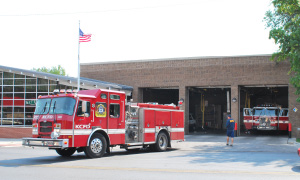
By LESLIE COLLINS
Northeast News
September 26, 2012
Ambulance response times continue to plague the Kansas City Fire Department.
While KCFD met city standards for basic life support response times in August, advanced life support times failed to hit the mark.
City ordinance requires that ambulances respond within 9 minutes 90 percent of the time citywide for life-threatening emergencies. During August, KCFD met that requirement 79.3 percent of the time.
However, KCFD is hoping ambulance service will improve through the use of several pilot projects. To further improve the system, the International Association of Fire Fighters Local 42 and the city of Kansas City will form a strategic plan, evaluating the weaknesses and the strengths of the fire department and Emergency Medical Services (EMS). The city’s last strategic plan was dated November of 2003.
KCFD personnel introduced the pilot projects during the city’s Sept.19 Public Safety and Emergency Services Committee meeting.
The pilot projects are a result of a Local 42 bargaining agreement which stipulated an EMS Task Force should be formed to evaluate the current deployment model and make recommendations for enhancement, said Interim Fire Chief Paul Berardi.
Pilot projects will be implemented in a controlled environment and will not coincide with each other, Berardi said. This will allow the department to accurately study the impact of each pilot project. Data from the pilot projects will also be used in the strategic plan.
BLS Transfer
Ambulances Project
The BLS (Basic Life Support) Transfer Ambulances Project aims to lessen the workload on EMS personnel working 24-hour shifts. Currently, an Advanced Life Support (ALS) transport unit is sent on all EMS calls, regardless of the situation.
“This results in ALS transport units being engaged on calls requiring no ALS intervention or support, increasing the workload demand on all such units in the system,” the EMS Task Force Recommendation Report stated.
The project would also free up additional ALS units for true life-threatening situations.
KCFD plans to use BLS units for non-urgent transfers from a hospital to a home or from facilities with a higher level of care to those with a lesser level of care.
“These are the patients that have been treated and the doctors need them to be able to be released and go home with limited care or no care at all,” said Deputy Chief of the Medical Bureau Tom Collins.
EMT-P (Paramedic) Pumper Pilot Project
Approximately 40 paramedics are part of the firefighter crew, but haven’t been allowed to function as paramedics and utilize their skills, said committee member John Sharp.
Current protocol states that ALS assessment and intervention can’t begin until an ALS transport unit arrives. However, assessment and intervention could begin sooner if KCFD utilized paramedics currently on fire suppression units. Using paramedics already on the scene could enhance patient care and reduce time on the scene, the Task Force report stated.
EMT-I (Intermediate) Project
Thanks to a $280,000 grant, KCFD will be able to train EMTs as EMT Intermediates on fire suppression units. KCFD hasn’t pursued this type of training in the past, the Task Force report stated.
The additional training would allow for more advanced life saving capabilities and “enhances our program even further,” Collins said.
EMT Intermediates would be able to perform more advanced airway procedures, administer intravenous therapy and would receive limited drug box education.
EMT Intermediates receive about 40 percent of the same training as a paramedic, said Kansas City’s EMS Medical Director Joseph Salomone.
BLS Primary Response Project
The BLS Primary Response Project will evaluate the impact of assigning BLS units to calls that a dispatcher determines are non life threatening. Using this method of response could balance the workload and “enhance availability of ALS units, thereby improving response,” the report stated.
















